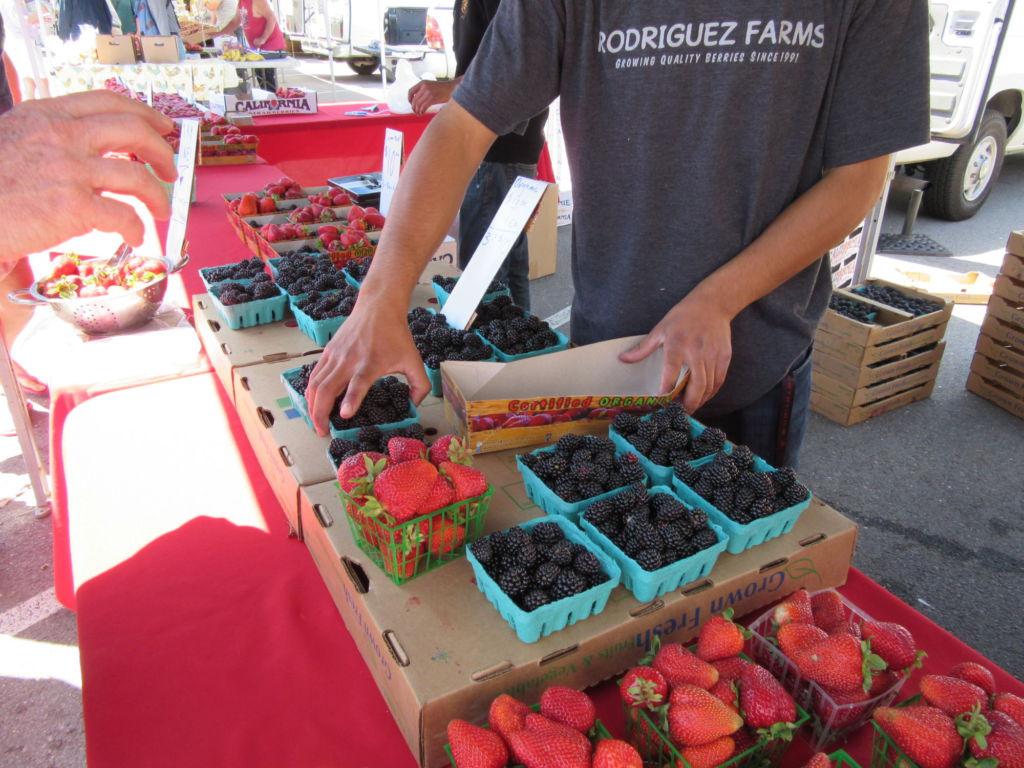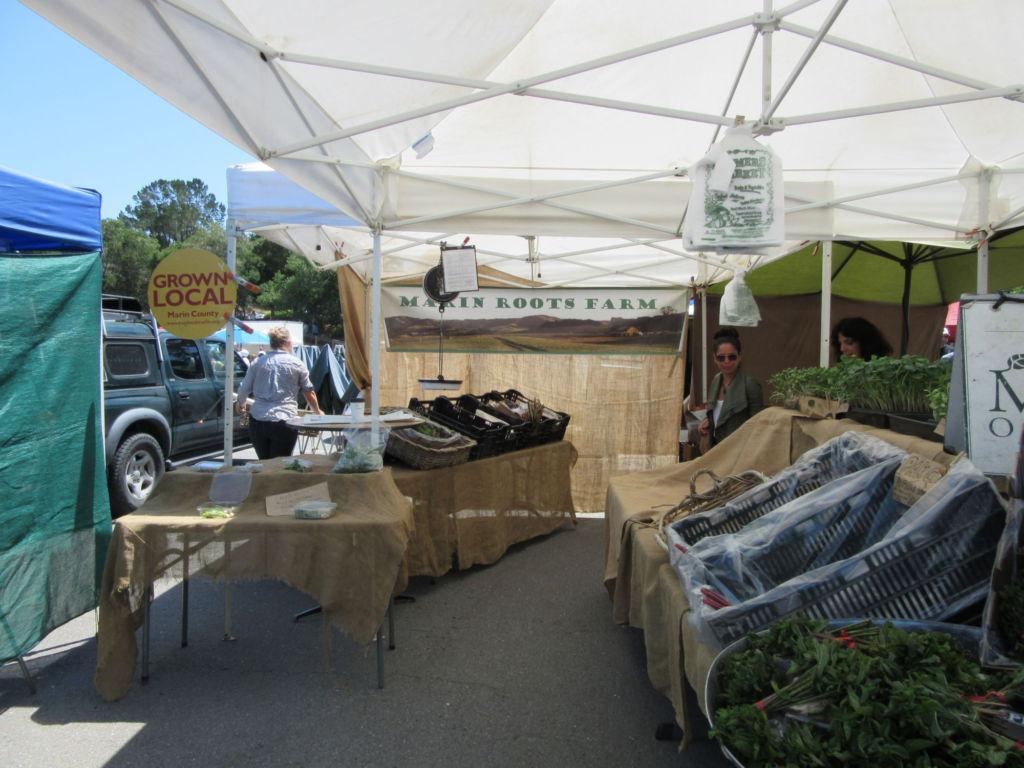The sweet scent of fresh berries fills the air as the morning light pours through the sky. Guitar strings strum, while people gather at the the heart of Marin’s agricultural distribution to purchase locally produced goods. Parents line up at the white booths with their children whose faces brighten as the farmers place juicy samples of cherries and strawberries into their outstretched palms.
After 35 years of hosting a successful Sunday gathering in San Rafael, The Agricultural Institute of Marin (AIM) Farmers’ Market is planning the creation of a permanent indoor market (Marin Public Market Hall) with daily vendors, as well as restaurants and cafes. This 30,000-square-foot market will be located next to the Marin Civic Center and will be open seven days a week if $24 million is raised by July 1, 2020. This idea of expansion demonstrates the attention that AIM receives from the community.
The AIM Farmers’ Market brings the community together by supplying fresh foods and produce, also allowing bonds to form between the farmer and the customer. The market is frequented by several local chefs who rely on the farmers for quality ingredients to bring to their restaurants. The farmers make numerous preparations before serving the public and some specifically fill chefs’ requests for certain crops.
According to Market Manager Nick Davantes, the market is packed to full capacity with 200 vendors and about 10,000 customers each Sunday. It’s the third-largest farmers’ market in California out of approximately 900. Running from 8 a.m. to 1 p.m. on Sundays, the market is open all year round.
A majority of the vendors are the farmers themselves, which allows for direct marketing, meaning the goods are sold straight to the customers from the people who grow them.
“The customer is getting exactly what they see from the person who grew it themselves. Not only that, but we do have customers who come here rain or shine – we see them every single week and it’s a pretty special thing to have them here every single week no matter what, because they support the farmers and the farmers really appreciate that,” Davantes said.
This bond between farmer and customer is especially appealing to Jesse Kuhn, owner and operator of Marin Roots Farm.
“I love meeting the people. The farmers’ market is really rewarding because I get to meet the people who eat the food that we grow,” Kuhn said.
Freshman Juliana Mckenna believes that there is a more welcoming environment at the farmers’ market than at a supermarket.
“[The farmers’ market] is very loud and vibrant. It’s just more friendly because there’s a lot of people willing to talk to you than in a closed building environment,” Mckenna said.
At the farmers’ market, most of the same goods are sold weekly, allowing a trust and reliance to form between the community and its local farms.
Trey Petrey, employee of Anderson Valley’s Pennyroyal Farm, said, “A lot of people come here and come to us because they see us here week after week and they know that they can buy our cheese that comes directly from the creamery. That’s super important.”
Sophomore Andrew Reinhard likes to attend the farmers’ market regularly with his mother.
“[I come here] probably every couple of weeks to see what’s new. It’s a lot of fun. I love fruit, and the Belgian Waffles here are really good. It’s good to get fresh local food grown by all these farmers around here,” Reinhard said.
According to Abi Warwas, vendor for Rainbow Orchard Farm in Camino, there are a number of benefits that come out of buying produce locally.
“One is freshness, which means it is going to last longer. Nutrients degrade over time as well, so it is going to be more nutritious regardless of whether it’s organic or not organic,” Warwas said.
Regional foods are advantageous as they have not been stored and carried improperly as many commercial crops are, according to the University of Vermont.
“It’s just the quality is so much better. I mean, things haven’t sat on a shelf or traveled on a truck or been refrigerated for extended periods of time,” Petrey said, comparing local produce to that available at supermarkets.
Though not all farmers believe that supermarket produce is bad, all of them pride themselves on the freshness of their own goods.
“I think that you can probably find some really good produce at the supermarket, but the farmers’ market is definitely fresher because in general the stuff is picked the day before and if not sometimes, the morning of the market, so it’s as fresh as it could be really,” Kuhn said.
Shopping at the farmers’ market aids the process of keeping money in a local premise as well.
“When you shop locally, you’re putting money back into the community. It keeps the money in a local circuit. It really benefits everybody in the community,” Kuhn said.
The convenience and containment of the market inspires chefs to buy their ingredients from AIM. According to the AIM website, chefs have been collecting their goods from the market since the early 1980s. However, new bonuses were introduced ten years ago to welcome more chefs to the market, such as “Chef Parking” with the special “Chef Carts” available. These new updated features allow the cooks to buy their produce in bulk amounts from local distributors.
Keven Wilson, executive chef of both Pizzeria Picco and Picco Restaurant in Larkspur, purchases all of the restaurant’s produce at the farmers’ market.
“I like to be able to look at what I’m getting. If you order from the produce company, often times you don’t know what you’re getting until it comes to the restaurant,” Wilson said.
Farmers are also willing to individually serve chefs with specific arrangements.
“Our main way of selling our products is through the farmers’ market, both to home shoppers and to restaurants. We do a lot of meetups and dropoffs through the farmers’ market with our restaurant accounts,” Kuhn said.
As Kuhn attends to chefs’ needs, Wilson benefits from the farm-to-table system that only farmers’ markets can provide.
“It’s good to be able to see what I’m buying and you build a relationship with the farmers. And they will actually grow things for you. There are some farmers who go so far as to if you bring them a seed, they’ll grow from seed for you. Other ones will just grow a crop if that’s what you’re interested in,” Wilson said.
In order to satisfy all of the buyers, the farmers need to consider the amount of preparations necessary to get them where they need to be.
Desirea Monahan of Le Grand Berry Farms, located south of Merced, picks blueberries daily and commutes approximately two and a half hours to the market.
“We get up at about 3:30 in the morning. We bring about 400 pounds to the market every Sunday,” Monahan said.
Farming is a difficult business to be in, not just physically, but also financially, according to Petrey.
“It’s a challenging business to be in to make money. With cheese, you’re dealing with a perishable product, so you never know and you have to hope that you’re going to able to sell all of that,” Petrey said.
However, Petrey believes, the feeling of serving the community by providing fresh food makes it all worth it.
“You invest a lot of money and a lot of time and a lot of work. So, the benefit in the long run is that you do something that you love and people that are buying it and coming to these markets really appreciate it and know that they’re getting really high-quality products,” Petrey said.


























